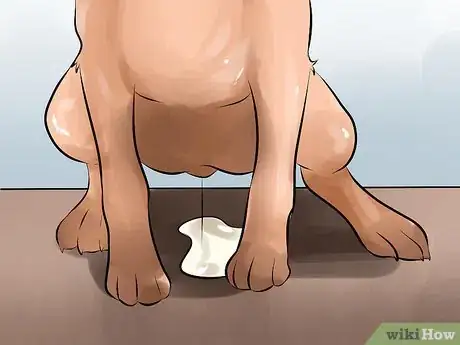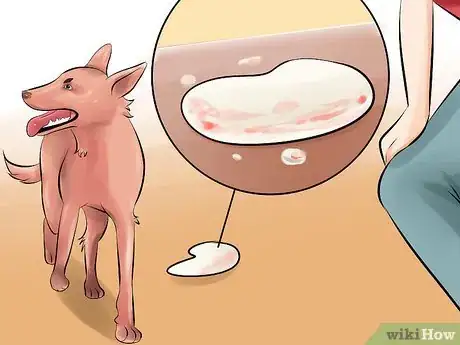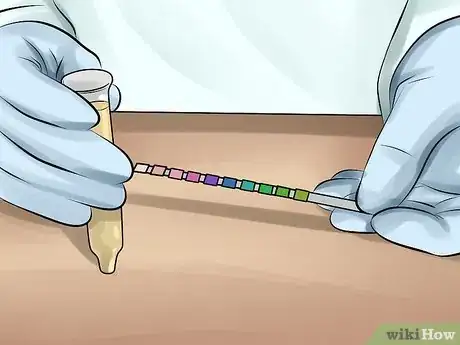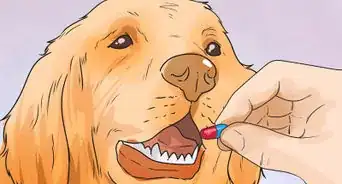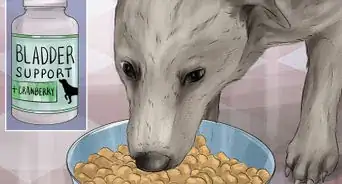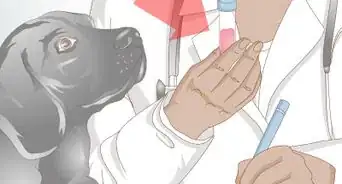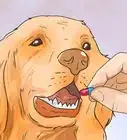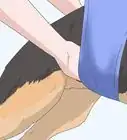This article was co-authored by Pippa Elliott, MRCVS. Dr. Elliott, BVMS, MRCVS is a veterinarian with over 30 years of experience in veterinary surgery and companion animal practice. She graduated from the University of Glasgow in 1987 with a degree in veterinary medicine and surgery. She has worked at the same animal clinic in her hometown for over 20 years.
There are 9 references cited in this article, which can be found at the bottom of the page.
wikiHow marks an article as reader-approved once it receives enough positive feedback. In this case, 100% of readers who voted found the article helpful, earning it our reader-approved status.
This article has been viewed 47,413 times.
Bladder infections are more common in dogs than in cats. Additionally, female dogs are more likely to get bladder infections. The bacteria that cause the infection usually come from the skin or mucous membranes lining the vulva or sheath and travel upstream via the urethra and into the bladder. Once in the bladder, the bacteria stick to the bladder lining and reproduce, producing toxins which irritate the bladder lining and cause inflammation. This inflammation and soreness are responsible for many of the symptoms associated with a bladder infection.
Steps
Recognizing the Symptoms
-
1Look for increased urination. Pollakiuria is the technical term for the feeling of constantly needing to empty the bladder. This sensation is caused by inflammation of the bladder lining and the nerves in the bladder wall. These inflamed nerves fire off inappropriately and send the misleading signal that the bladder is full and needs to be emptied.[1]
- In all likelihood the bladder will be empty (because of the constant attempts to urinate) but the dog still has the urge to urinate.[2] Unfortunately, the muscular contractions trying to ring out an already empty bladder cause further inflammation.
- When a dog is suffering from pollakiuria, she may experience a sudden urge to empty her bladder and may repeatedly ask to be let outside. Once there, she may take a few steps and squat down, only to sit there for a minute, then get up, walk a few steps and squat down again.
- At night, this might cause the dog to squat in the house, and you might come down in the morning to spots of blood-stained urine scattered over the floor.
-
2Watch for signs of discomfort during urination. A normal bladder is lined by a protective layer of mucus which helps shield the delicate tissue of the bladder from urine. The inflammation associated with bacterial toxins strips away this protective layer, exposing the mucous membrane lining to more bacteria and toxins.[3]
- As the bacteria breed they also change the pH of the urine from slightly acidic to slightly alkaline. This change in pH is a further irritant to the bladder lining.
- The stinging sensation that causes stranguria (the technical name for discomfort during urination) is caused by the contraction of the inflamed bladder, and the bladder lining being exposed to the flow of urine.[2]
- Signs of stranguria include discomfort and pain, and your dog may whine or yelp while trying to urinate. Another sign might be the dog jumping up and running away from the spot as she tries to urinate. Other dogs may shuffle along in a squatting position as if trying to walk away from the discomfort.
Advertisement -
3Keep an eye out for blood in the urine. Bladder inflammation may cause blood to seep from the fine blood vessels in the bladder wall. This blood then collects in the urine. Sometimes the blood cannot be seen with the naked eye, but can be detected on a dipstick test (hence the importance of taking a urine sample to the veterinary clinic).[4]
- Small amounts of blood make the urine appear a deeper yellow than normal. Larger amounts of blood tint the urine red, the depth of the shade of red depending on how much blood is present.
- Sometimes blood-stained urine can look alarming if it is a deep red color or contains blood clots. If this happens, don't panic; the dog is extremely unlikely to hemorrhage from the bladder, and this type of bleeding is rarely life-threatening in the short term.[5]
- However, this does not mean you should ignore blood in the urine. It is a warning that the pet needs treatment, and it is possible for a dog that loses blood in the urine over several weeks or months to become anemic as a result.
-
4Monitor the dog for offensive smelling urine. Some bacteria change the composition of the urine and give it an unpleasant odor. The odor is hard to describe, but is most commonly described as a "fishy" smell.[6]
- If the dog's urine smells different from usual it is likely to be significant, especially when combined with other symptoms.
Looking for Behavioral Signs
-
1Take note of any breakdown in house training. For some dogs, the feeling of needing to urinate overrides their house training. This can result in such urgency to urinate that the dog squats in the house, or urinates in forbidden places.
- Do not punish the dog for this. This is not a true loss of house training but is simply a behavior provoked by discomfort. Once the infection is treated, the inappropriate urination will stop.
-
2Watch for excessive licking of the vulva or penis. The scalding, burning sensation the dog experiences when passing urine may extend along the urethra to the external genitalia. This can result in the dog licking themselves excessively as a means of numbing the discomfort.[7]
- Like a child sucking their thumb, some dogs also find the repetitive nature of licking soothing, and will do this to comfort themselves.
-
3Take note if your dog shows increased thirst. Some dogs will instinctively drink more in order to try to dilute the toxins in their urine. You may notice the water bowl needs filling up more often, or the dog starts seeking out puddles to drink from.[8]
- However, a dog with a sore bladder is not able to hold onto a large volume of urine in the same way a healthy bladder can, and is more likely than ever to need to urinate frequently.
Getting the Dog Tested
-
1Bring your dog to the vet for testing. It should be noted that the bladder has a limited number of ways of responding to problems, be that an infection, a polyp, a bladder stone, or a bladder tumor. If your dog has blood in the urine, or experiences discomfort while urinating, this is not normal and you should seek veterinary advice.[9]
- Where possible, take a sample of the dog's urine with you to the consultation. The vet may decide to run a dipstick test, look at the urinary sediment under the microscope, or send the sample for culture.
- Either way, if the vet has a sample easily at hand it speeds up the investigation process.
-
2Understand how a dipstick test works. A Dipstick is a stick of plastic with a glued pad that changes color in the presence of substances such as blood, protein, glucose, ketones, and white cells.[10]
- The dipstick is dipped into the urine and the excess liquid is tapped off. The clinician then waits 30-60 seconds (according to the directions on the dipstick packaging) and compares the different reagent pads to the reference color chart.
- This gives a quick reliable answer as to whether blood is present (healthy urine does not contain blood).
-
3Be aware that infection is just one possible cause of blood in the urine. Other reasons include bladder stones, urinary crystals, bladder polyps, and neoplasia. Differentiating between these requires further tests such as urine cultures, urine sediment exams, ultrasound imaging and/or radiography.
- However, if the pet is otherwise well and this is the first time he or she has presented with haematuria, many clinicians opt to start the pet on treatment (antibiotics and pain relief) whilst waiting for culture results to come back.[11]
Expert Q&A
-
QuestionCould a bladder infection be caused from having to hold in urine for a long time? I live in an apartment and work long hours, and my dog has to hold it until I get home. She's starting to show symptoms of a bladder infection.
 Pippa Elliott, MRCVSDr. Elliott, BVMS, MRCVS is a veterinarian with over 30 years of experience in veterinary surgery and companion animal practice. She graduated from the University of Glasgow in 1987 with a degree in veterinary medicine and surgery. She has worked at the same animal clinic in her hometown for over 20 years.
Pippa Elliott, MRCVSDr. Elliott, BVMS, MRCVS is a veterinarian with over 30 years of experience in veterinary surgery and companion animal practice. She graduated from the University of Glasgow in 1987 with a degree in veterinary medicine and surgery. She has worked at the same animal clinic in her hometown for over 20 years.
Veterinarian It's best to give your dog more opportunities to relieve itself, especially if it's prone to bladder infections. When the dog needs to hold its urine for a long period of time, the dog's bladder is exposed to the bacteria for a longer period of time. This makes it more likely that an infection will develop.
It's best to give your dog more opportunities to relieve itself, especially if it's prone to bladder infections. When the dog needs to hold its urine for a long period of time, the dog's bladder is exposed to the bacteria for a longer period of time. This makes it more likely that an infection will develop.
Warnings
- One or all of the symptoms described above may be present, but not every dog will have all the symptoms.⧼thumbs_response⧽
References
- ↑ https://pets.webmd.com/dogs/guide/lower-urinary-tract-problems-infections-dogs#1
- ↑ 2.02.1Small Animal Internal Medicine. 3rd edition. Nelson and Couto. Publisher Mosby. p627
- ↑ https://www.akc.org/expert-advice/health/noticing-dog-uti-symptoms-could-be-something-more/
- ↑ https://www.akc.org/expert-advice/health/noticing-dog-uti-symptoms-could-be-something-more/
- ↑ The 5 Minute Veterinary Consult. Tilley and Smith. Publisher Williams and Wilkins. p 776-777
- ↑ https://www.petmd.com/dog/general-health/what-your-pets-urine-says-about-their-health
- ↑ https://vcahospitals.com/know-your-pet/why-dogs-lick-their-privates
- ↑ https://www.care.com/c/stories/6335/dog-bladder-infection-7-tips-to-help-your-do/
- ↑ https://pets.webmd.com/dogs/guide/lower-urinary-tract-problems-infections-dogs#2-7
